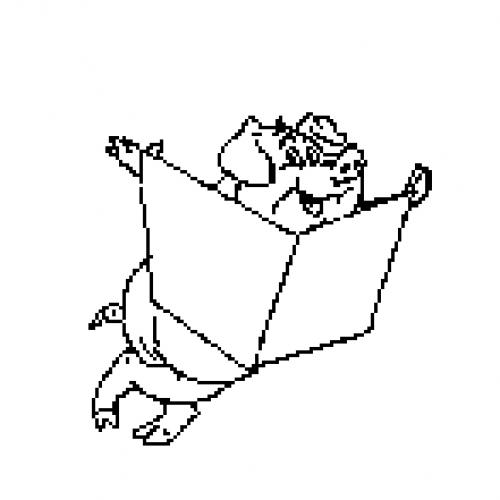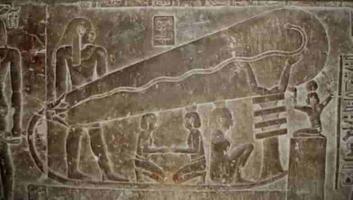Copy Link
Add to Bookmark
Report
Pig Genome Newsletter #016

Pig Genome Update No. 16
January 1, 1996
-------------------------------------------------------------------------------
Several meetings have been recently held which offer new insights for livestock
gene mappers. Below are summaries of some of them attended by of our
colleagues.
The HUGO Comparative Genome Workshop was held on December 3-6 on Frasier
Island, Australia. This meeting was the first such workshop held to solely
consider topics associated with comparative gene mapping. It was attended by 60
individuals representing mice, rats, cats, dogs, marsupials, deer, cattle,
pigs, birds, fish, Drosophila, and informatics. The goals of the workshop
included updating the existing maps, comparing similarity among species,
coordinating databases and improving efforts to support comparative mapping.
The sessions included small presentations on the comparative maps, vertebrate
genomic evolution, phenotypes, diseases and QTL, and informatics. The meeting
was attended by several pig gene mappers from the PiGMaP consortium, members of
the NAGRP and by the U.S. Genome Coordinators for pigs and cattle. Data for the
mouse and rat were clearly the most extensive with over 1,500 genes mapped in
the mouse. In the pig, there are now over 210 mapped genes in PiGBASE, and
perhaps 30 more in press and 30 in the research databases. It is likely that an
additional 1000 ESTs exist. The average size of conserved segments between the
pig and human is about 37cM. Data for cattle, sheep and birds was also
presented which showed a smaller number of genes mapped. Drs. Leslie Lyons and
Steve O'Brien discussed plans to share information on PCR primers on a set of
over 300 anchor loci for all species. These were chosen such that they had
excellent coverage in the human and the mouse and would provide a framework in
other species. A presentation of The Comparative Animal Genome database
(TCAGdb) was made by Dr. Alan Hillyard. One special part of the meeting was
devoted to correct use of nomenclature. Conserved synteny was defined as the
association of two or more genes on the same chromosome in two species. A
conserved segment was defined as a continuous segment of genes linked together
in two species and conserved order was defined as the same linkage order in two
species. The naming of new genes was also discussed and sharing names with the
human gene nomenclature committee prior to publication was encouraged. The
workshop closed with a final session devoted to plans for the future. This
included writing of a workshop report which Mammalian Genome will publish in
1996. The report will include information on the value of the comparative maps,
mapping strategies, status of species maps and a fold-out comparative map. It
is hoped that this report will be useful in generating more support for
comparative gene mapping. Future meeting plans were also discussed. The
organizers of the meeting, Drs. Steve Brown, Jenny Graves, and Jay Hetzel did a
superb job in organizing this important meeting. Those wishing copies of the
pig abstracts can e-mail me at mfrothsc@iastate.edu .
A Livestock QTL Workshop was held on December 7 in Brisbane and hosted by Jay
Hetzel. The purpose of this workshop was to present information in QTL results
in cattle, pigs, sheep and deer. Several interesting results were presented
which included studies and apparent QTL for growth, meat quality, excess sheath
skin and double muscling in beef cattle, milk and fat traits in dairy cattle,
and growth, backfat and litter size in pigs. Plans for several new QTL
experiments were also discussed. Of particular interest was the open discussion
at the end of the meeting in which concerns were raised on analysis of QTL
data, funding opportunities and the need to pass useful results on to the
livestock industry. The meeting was attended by 30 individuals from Europe, the
U.S., Australia and New Zealand.
The Sixth Australasian Gene Mapping Workshop and New Zealand Genetical Society
Conference was held in conjunction with a Mammalian Interspecies Hybrid
Workshop in Dunedin, November 27-December 1. The meetings consisted of 62 oral
presentations and 40 poster presentations on plant and animal genetics and new
technologies with a heavy emphasis on markers and complex traits. The mammalian
interspecies hybrid workshop focused on the biology of interspecific hybrids
and their value in the study of genomic imprinting and in constructing linkage
maps. Maps under construction using the interspecific hybrid approach were
presented for cats (Lyons), deer (Tate), mice (Copeland), pigs (Andersson),
cattle (Womack), and marsupials (Cooper) (kindly provided by James Womack).
The ISAG Pig Workshop in Ghent was held on November 15-17 and was attended by
about 40 people from a number of different laboratories. The reports included
information on blood groups and biochemical polymorphisms, immunoglobulin
markers, gene mapping and reports on QTL for litter size, disease resistance
and neuromuscular disease in pigs. Overall physical and linkage maps in the pig
were discussed as was an updated map with over 35 genes of the SLA region in
the pig. Considerable progress has been made in France and in Germany with
development of YAC libraries and their use in identifying and mapping genes was
discussed at length. Further information will be published from this meeting in
the form of abstracts and activity reports and will be made available probably
in January. Those interested in details about the meeting or abstracts can
contact me at mfrothsc@iastate.edu .
The International Symposium on Swine in Biomedical Research was held at the
University of Maryland at College Park on October 22-25, 1995. The first
session on basic physiology emphasized the importance of the pig for
cardiovascular and pulmonary studies, and as a model for endotoxemia and
intestinal pathobiology. Later sessions emphasized use of pigs for pharmacology
and toxicology research. The pig has increasingly become an important model for
studies of neonatal metabolism, of total parenteral nutrition, and of hormonal
influences on metabolism. Improved swine management procedures will enable
scientists to use the pig more effectively for basic research as well as for
behavioral studies and analyses of stress effects. Several speakers documented
the current availability worldwide of numerous lines of miniature swine and
their genetic interrelationships. The second session focused on the use of pigs
as a model for transplantation. Within species (allotransplantation) studies
have enabled scientists to analyze the allograft rejection process and
possibilities of retroviral vector systems for inducing alloantigen tolerance.
Xenotransplantation (between species transplantation) using the pig as the
organ or tissue source has recently become a major focus of research. Several
companies have produced transgenic pigs expressing different human complement
inhibitors as they try to overcome the hyperacute rejection response. Several
scientists emphasized the importance of engineering transgenes for appropriate
levels and tissue specificity of expression and of producing swine embryonic
stem cells for broader studies of genome modification. The development of a
detailed swine genome map has meant that analyses of the genetic control of
disease responses can be investigated. Studies on the spontaneous regression of
melanoma have indicated that a major gene regulates inheritance of melanoma.
Despite the inverted structure of its lymph nodes the overall physiology of the
pig immune system is quite similar to humans. Cellular and soluble immune
regulatory functions are quite analogous although the pig is notable for the
presence of high numbers of peripheral CD4/CD8 double positive T cells and for
the limited number of variable immunoglobulin (Ig) genes, a single joining (J)
segment and no IgD. Effector mechanisms against infectious diseases are quite
similar to humans with the emerging importance of certain infections being
attributed to major changes in management procedures. Overall, this symposium
was an effective means of documenting the importance and applicability of swine
for current biomedical research. The meeting was organized by Drs. Mike
Tumbleson, Univ. Illinois-Urbana, and Larry Schook, Univ. Minnesota, St. Paul
and proceedings will be published by Plenum Press (kindly provided by Joan
Lunney).
The 9th International Mouse Genome Conference took place in Ann Arbor, Michigan
from November 12-16, 1995, and was attended by over 300 scientists from around
the world. Sessions included Mutation Identification, Comparative Mapping,
Informatics, Complex Traits, Mutagenesis, Gene Identification, New Technology,
and Genetic and Physical Mapping. The mouse genetic linkage map now has over
6,500 markers, and most efforts are shifting towards development of physical
and transcriptional maps. Each chromosome is represented by committees that
maintain and organize the mapping efforts for that chromosome. Many mutations,
disease genes, and other single-locus phenotypes have already been positionally
cloned, and dozens of other genes are close to being identified and cloned. In
addition, several efforts in mouse QTL identification are in progress, and a
few QTL should be positionally cloned within the next few years. QTL efforts
focus on obesity, disease susceptibility and behavior. Many of the new
technologies and mapping reagents that are being developed for mouse genome
mapping will have direct relevance for livestock genome mapping efforts (kindly
provided by Daniel Pomp).
Several of the meetings reported in Pig Genome Update including the Swine in
Biomedical Research and the HUGO Comparative Genome Workshop received some
funding from the U.S. Swine Genome Coordination effort. If you have a
worthwhile meeting and would like support please visit with the Coordinator
concerning your request.
As previously reported a new set of 25 primer pairs has been produced and is
available. This brings the total to 294 pairs of primers that have been shipped
to gene mappers and QTL researchers in over 26 labs in 10 countries. Please
request a set if you want the latest addition to the previous set of primers.
Ideas from pig gene mappers are always appreciated. A list of microsatellite
primers that could be used in automated genotyping projects is being compiled
by a committee of D. Pomp, B. Kirkpatrick and C. Tuggle thanks primarily to the
help of Martien Groenen and Denis Milan. If you have experience in this area
and want to help please contact one of the committee members or me. Once a list
is complete, we will consider making fluorescent markers for some or all of
these primers. Other ideas of services that can be provided as part of the
coordination effort are under consideration. Your thoughts would be
appreciated.
Pig Genome Home Page grows. We continue to update the home page for pig gene
mapping. It serves as a gateway for other databases, information on gene
mapping, newsletters, meeting updates and much much more. This is your home
page so please give us your ideas to include.
Confused by all databases and how to use them? Pig Genome Update 15 had
directions to help you out. Just go back to our WWW home page and look at the
Update 15. If you have any questions and problems, just let us know. We expect
several new database developments. We will be developing in conjunction with
Alan Hillyard and PiGMaP a new pig database containing more detailed
experimental information. In addition, a new database, named TCAGdb for The
Comparative Animal Genome database, is planned that will pull together the data
from the single species databases for cross-species comparisons.
Upcoming meetings:
Plant Genome IV, San Diego, CA January 14-18, 1996
Midwest ASAS/ADSA meetings, March 18-20, 1996, Des Moines, IA
Genetic Susceptibility & Complex Traits, Vancouver, Canada, April 17-19, phone:
212-726-9281
XXV International Conference on Animal Genetics, International Society of
Animal Genetics, Vinci Congress Centre, Tours, France, July 22-26, 1996,
contact guerin@biotech.jouy.inra.fr for details
Allerton II, Genetic Analysis of Economically Important Traits in Livestock,
Allerton Park, Illinois, November 1996, contact h-lewin@ux1.cso.uiuc.edu for
details
Contributions to Pig Genome Update 17 including short meeting announcements are
always welcome. Please send by the 10th of February.
Holiday greetings to you, your families and friends. May this new year be
filled with good health, happiness and success.
Max F. Rothschild
U.S. Pig Genome Coordinator
225 Kildee Hall
Department of Animal Science
Iowa State University
Ames, Iowa 50011
Phone: 515-294-6202
Fax: 515-294-2401
mfrothsc@iastate.edu
Paid for by funds from the NRSP-8 USDA/CSREES sponsored pig genome coordination
program
-------------------------------------------------------------------------------
* Return to Previous Menu














